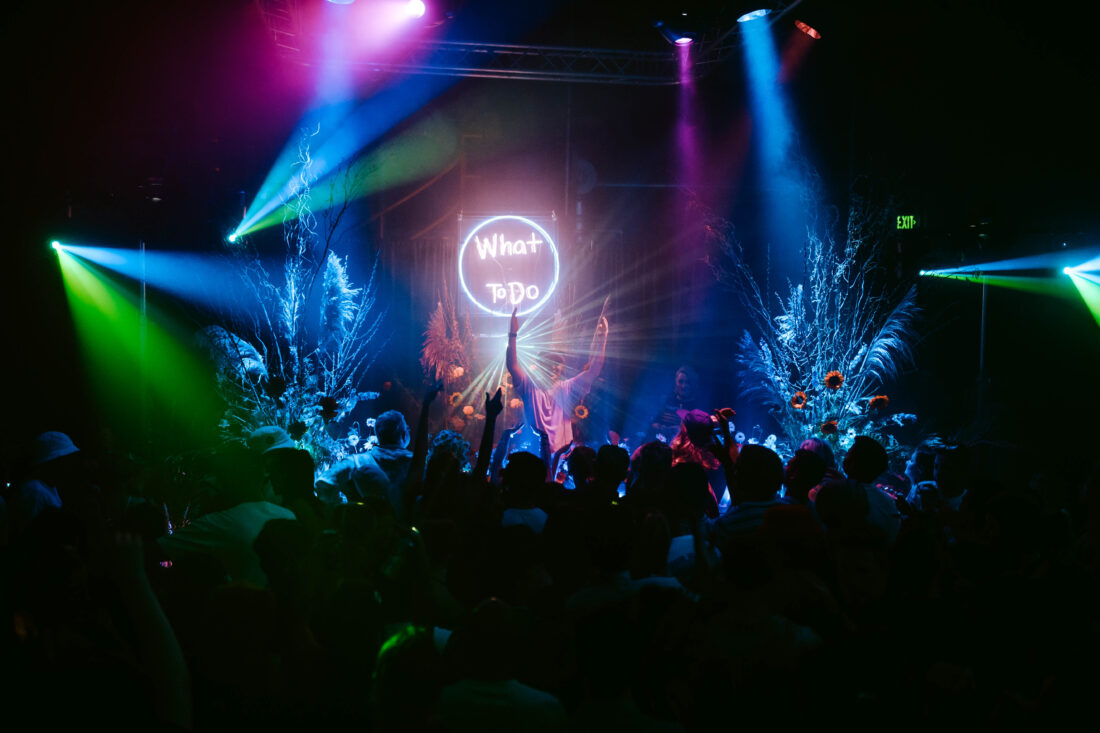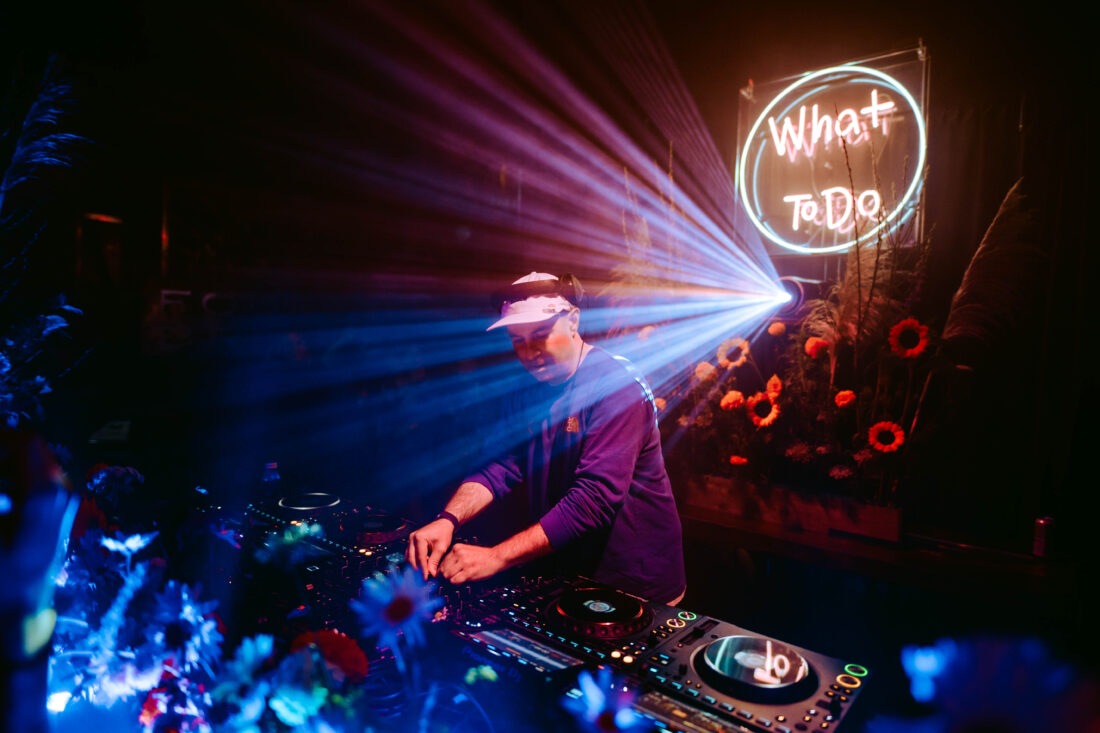The lights are mobile. The bass is rumbling. The people are dancing. The energy is high at Denver’s Mission Ballroom this October evening for the Desert Hearts takeover, and in the last few moments before the lights come up, Justin Martin is capping off the night with one sound, in particular.
This sound is sitting atop the illustrious evening like a glistening bejeweled crown upon the head of a regent so loved and respected that history books will write tales of how her people cheered for her.
Conversely, it’s a sound that practically never finds its way within the perimeter of a venue hosting dance music. It’s the sound of the harp. The metallic clang of wired strings circumvented by a mystical and harmonious ring.
Slowly, out of the bumping mix, repeated strums of the harp emerge, casting a calming glow on the audience as space opens within their hearts for emotions to come through (alongside the unbridled joy ubiquitous of the night in question), and one such emotion is a familiar contentment.
Everyone knows the track. Justin is playing “Don’t Go (VIP).”
See, despite the fact that the harp is unconventional in such an environment, everyone familiar with Justin Martin is expecting music that falls outside the lines.
Consider the sound of his early classics like “Don’t Go (VIP)” to his newest single, “Defrost My Heart,” with Victoria Rae. Sure most have a four-on-the-floor beat, but even the broad term “house music” may be inaccurate (and even diminutive) due to the surplus of subtlety and emotion within the seams of his productions.
As with all art, Martin’s approach to his music is an extension of himself, and thus, this unconventional approach applies to the way he presents himself as an artist as well.
“I never really tapped into the full mainstream EDM. I’ve been out on this fringe and I love it. I’m OK with that. I’m not trying to be some superstar,” Martin says sitting in the green room of Mission Ballroom minutes before sharing the stage with Mikey Lion of the Desert Hearts crew
From professional operations such as working without a traditional artist team around him (instead relying on close friends with good instincts) to his candor and openness with his fans (with whom he frequently communicates in public spaces like Instagram), Martin’s intentions are about creating something pure, fun, true to himself, and true to the supportive community surrounding him.
Fueled by these same intentions, the next creation Martin is working on is his record label, What To Do.
“I’ve always liked the ambiguousness of the three words ‘What To Do’ because it could be a question or it could be a command or a suggestion. I prefer it more as a suggestion than a question. It’s leading by example. I wanted to create a platform that I could not only release my own projects on, but that could help other artists I believe need to be heard,” Martin says. “I want to release music that makes people feel something on the dancefloor.”
As a label, What To Do isn’t brand new. The first release was Martin’s single “Needs” for which he handled all the music, artwork, post-production, promotion, and distribution when he put it out at the beginning of 2020.
From there, he continued this “do it all myself” trend for all 15 releases on What To Do up until this point (all of which were his own music save for a few remixes), but he realized this trend was not even close to sustainable, especially with a full touring schedule that begins in March and is “relentless” until after Halloween.
Now, a new phase is beginning for What To Do. The label has its first-ever signees other than Martin himself. It has a new distribution deal (that took almost six months to solidify), and a new label manager, the respected house artist, Astronomar.
Furthermore, along with this progress for the label, Martin also has a new outlook on his own life and career:
“I’m so content right now. It’s a very happy bubble,” Martin says. “I just want to keep filling that space with stuff that I really, truly believe in. I have no idea how it’s going to do. Could hit. Could flop, but I know that we’re back taking chances and we are releasing stuff from the heart.”
Unfortunately, as often happens, this new outlook came as a dualistic response to difficulty. Martin had to learn things the hard way, and the hard way involved him being within the lines—being within what the music industry ostensibly demands from artists.
Because once the industry reopened after pandemic-related lockdowns, there was a massive landrush of music and events stemming from a palpable tension surrounding the urge to make up for lost time.
This led to severe inundation—a spiraling kind of inundation fueled by the endless comparisons resulting from social media and the “if it works for them it’ll work for me” mentality.
The scene was more saturated than it had ever been, and Martin was a part of that.
“I was selling out every single show, but for some reason, I still felt like it wasn’t enough,” Martin says. He recalls a night in the days leading up to the first Portola in San Francisco back in October of 2022.

His house in Oakland was full of friends who had come to the Bay to see his set, and instead of enjoying the company of his loved ones, he was in the studio making music.
Even though he was only playing for an hour (and he had enough unreleased music for three hours minimum) he, again, still felt like it wasn’t enough.
“My buddy comes down the stairs and says, ‘Dude, you’re good. You don’t need to finish this last thing. Look around you. Your friends are here to support you. Look at what you’ve accomplished for yourself. Look at this studio. Your family’s here,’ and I couldn’t see it in that moment,” Martin says.
In the next few weeks that followed, Martin did see it, though. Moreover, he saw that he needed to slow down and take a breath. He cancelled shows for the first time in his career, and from there began to shift his life back into balance.
He prioritized his mental health by starting therapy. He created a less demanding studio schedule, turning off his computer by midnight rather than 4AM. This summer he even took a break from the studio as a whole.
Most of all, he realized it was OK to forgive himself if he didn’t live up to the unrealistic standards he perceived from the industry (and himself).
“I needed to take a step back and be a little more kind to myself. Revaluate the people I was working with, where I needed help, and where I needed to ask for help,” Martin says. “ I needed to evaluate my relationship with the music.”

A major aspect of this reevaluation was Martin’s relationship with Dirtybird, with which he severed his involvement in early 2020.
Since the genesis of Dirtybird in 2005, Martin was a key player. He helped build it from free parties in Golden Gate Park to a global force of dance music culture.
But as time went on and Dirtybird grew, Martin realized he didn’t fit within the lines of Dirtybird either. He’s still on good terms with them, but after one of his releases was sent back with notes (something that had never happened in over a decade), he knew it was time to break out on his own.
Dirtybird’s community is known around the world, and Martin is now building his own community around his own ethos.
“One of my goals with [What To Do] is to grow a new community around a new sound,” Martin says. “We’ve done it once before I know I can do it again.”
For Martin, everyone who has supported him over the years is a part of that community. From the friends who were visiting him before Portola, to the new team who are working with him on What To Do, to the people who may only ever interact with him on social media but still ground him in the fact that he can use those channels to share from the heart rather than to chase trends and build clout.
And, of course, another aspect of that community is the new artists who will soon release music on What To Do
“I truly believe in the people I’m signing, not only as musicians but as awesome people. We’re on the brink of this big collaborative group effort,” Martin says.
The first signee who will release music on What To Do in this new phase is named MNTRA, a SoCal-based producer and artist who has already developed an impressive reputation.
Currently, MNTRA is on a tour of North America serving as direct support for the alternative house music outfit, The Sponges, in addition to forming his own group effort, Boiz House (which performed at Dirtybird Campout 2022) and sharing releases on prominent labels like Box of Cats and Space Yacht.
“MNTRA is such a beloved character. He has his own incredible beautiful community surrounding him and supporting him,” Martin says. “He sent me a [drum & bass] demo in 2022 that I just fell in love with instantly. It was exciting for me because I don’t want to just release house or tech house. I want to release whatever I like.”
After that first demo, MNTRA kept sending music, eventually sharing an album that Martin admits was a bit rough around the edges, but had within it the soul of What To Do. Thus MNTRA’s album will be coming out on the label in the near future.
What’s interesting is that Martin first received the music while he himself was in that phase of precipitance, and he initially wanted to get MNTRA’s album out before the end of summer 2023.
But after his own personal realignment along with the various hurdles like the lengthy process of solidifying a new distribution deal, the release will be approached with far more intent.
As such Martin’s had time to work with MNTRA on all the different aspects of the project: the visuals, the story they’re going to tell, how the singles will roll out into the album; really just how he plans to introduce MNTRA to the world beyond his existing fanbase.
“Not rushing, taking a breath, him being extremely flexible with it, being open to listening, being open to being patient with the whole process is going to be very beneficial in the long run,” Martin says.
That is how Martin is approaching his life and career in this new phase, and furthermore, he is setting that example to all the artists he’s working with and everyone on his team.
It may sound simple, but given it’s a lesson that Martin only learned years into his evolution as an artist, the idea of the endless grind is clearly still what’s expected from artists in 2023.
In order to shift that perspective it takes role models like Justin Martin to work outside the lines, and with the era of What To Do 2.0 approaching ever-faster, soon a whole community of artists will be working outside the lines towards the ultimate goal of making you feel something on the dancefloor.
Featured image provided by Saylor Nedelman – @storiesbysay








